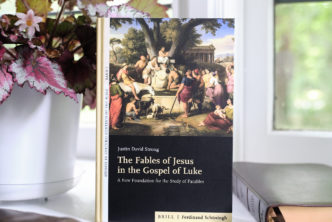
Part 4 of the series Observations from a Linguistic Spectator: An Annual Report. For part 1, see here. For part 2, see here. For part 3, see here.
Introduction
In the last post, we’ve considered some basics of grammatical aspect and the lexical actional potential of verbs. This part of the series continues this exploration. In particular, we will look at some other dynamics that occur when these two factors interact. Again, I would recommend to you reading Thomson’s essay for a fuller account. We will also address some practical issues that arise when it comes to dealing with aspect and Aktionsart in our daily exegetical work. Note that the categories that were introduced in part 3 of this series will be presupposed here. So if you are new to this subject, I would strongly encourage you to read that post first.
Reinterpretation of situations because of grammatical aspect
The combination of certain actional potentials with a certain aspect results in reinterpretations of the situation type. For example, if an accomplishment like κατασκευάζειν is portrayed through the imperfective aspect, we get an activity. In German, where we don’t have aspect as a grammatical category, we express this different “aspectuality” (it’s the broader category, just like temporality vs. tense) lexically by having an atelic verb (“bauen”) and a telic verb (“erbauen”).
In part 4 of Thomson’s article you can find a systematic account of possible reinterpretations due to aspectual modification. He has produced some very nice illustrations (all following illustrations are taken from that essay) that help a lot in communicating what this is all about. Here’s for example an accomplishment in the imperfective and the perfective aspect. The rising line indicates the movement towards a goal. The shaded area represents the reference time as it is determined by the aspect. (Note that this particular example of an “accomplishment” is called an “active achievement” in more recent literature. It is formed by adding an endpoint to an activity predicate.)
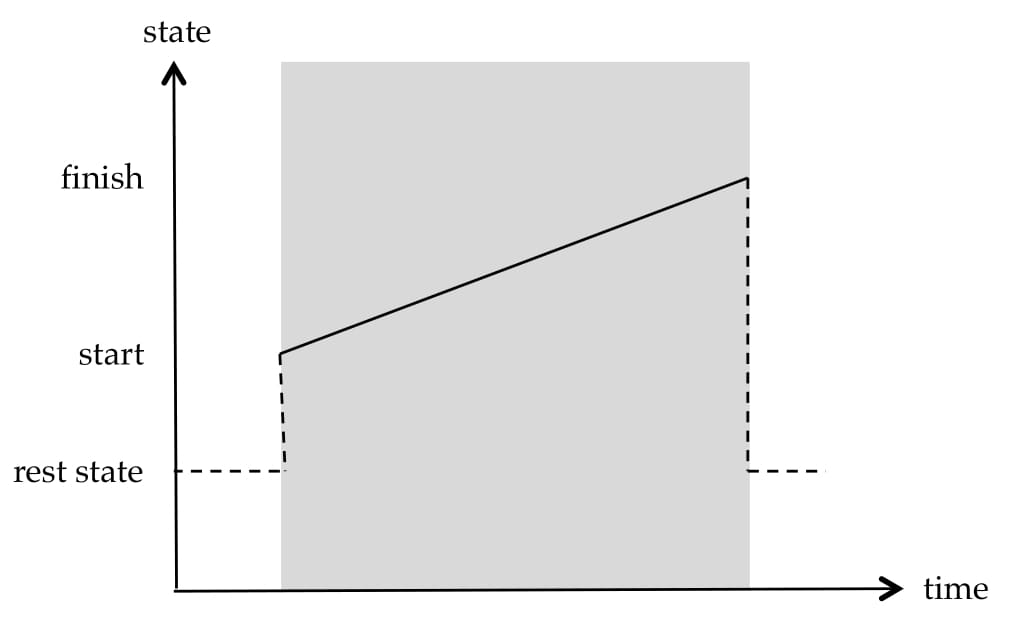
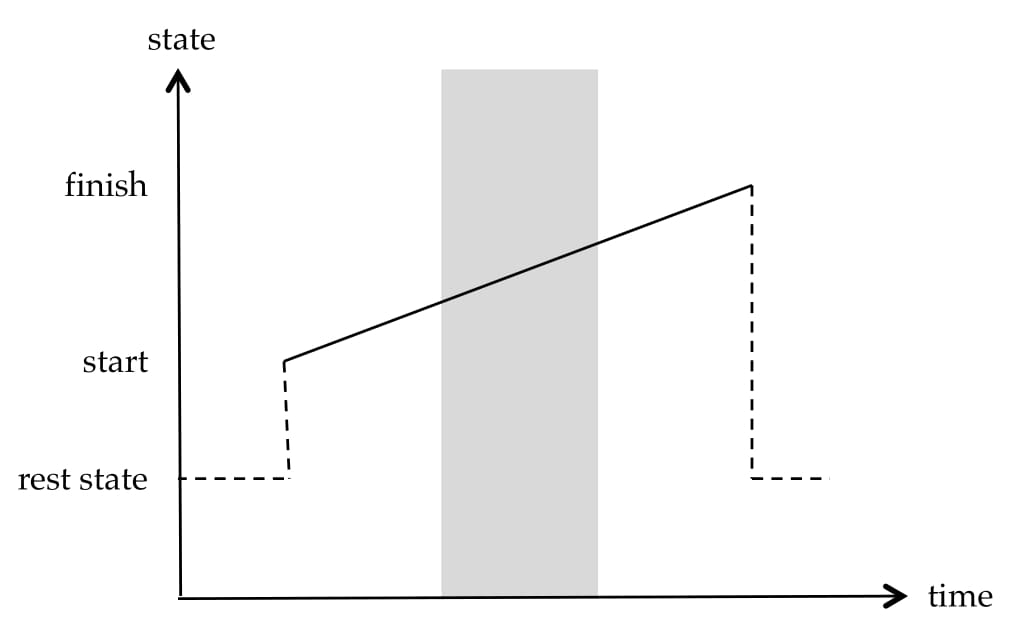
In the same way, you can now see how durativity is of importance. Take for example the semelfactives. A flash of lightning is over so soon that it’s not possible to find a reference time within the event time, or at least not a reference time that excludes the end of the situation. Therefore, for such a statement to be still acceptable, an iterative re-interpretation occurs with the result of a series of flashes being communicated.
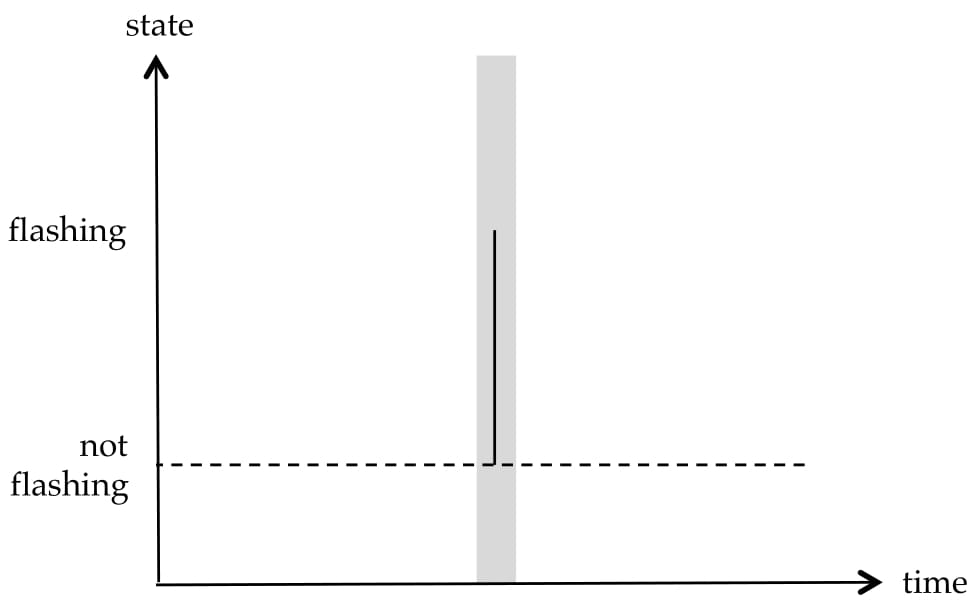
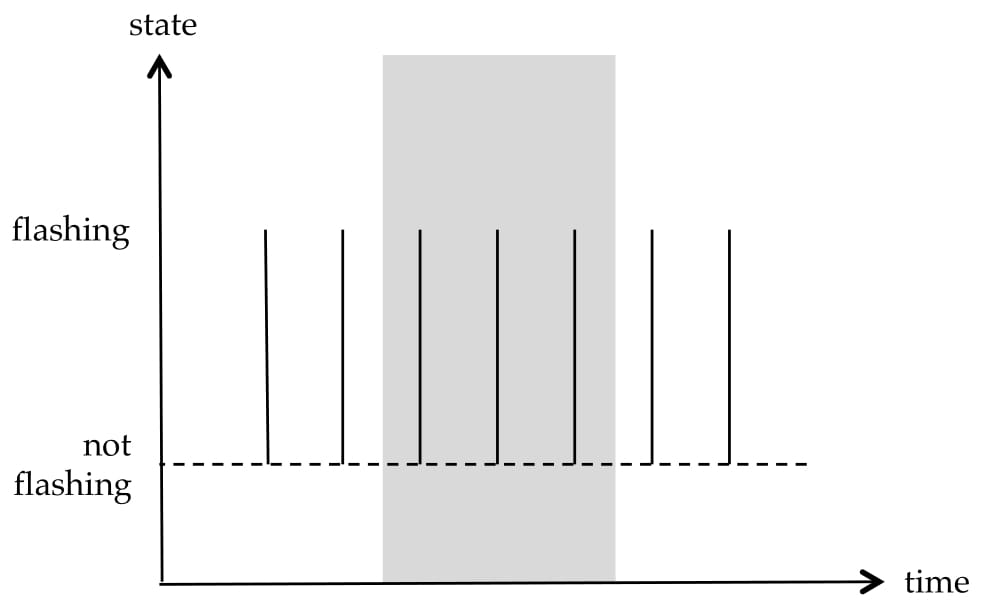
Something interesting also happens with achievements that contain a “preface” that leads up to the punctual situation. [Christopher find something] would be an example. Here the moment of finding is preceded by an activity of searching. The perfective aspect simply focuses on that moment of the find itself. However, the imperfective aspect has the same “problem” here as with the semelfactive – with the result that a shift of reference time towards the preface occurs.
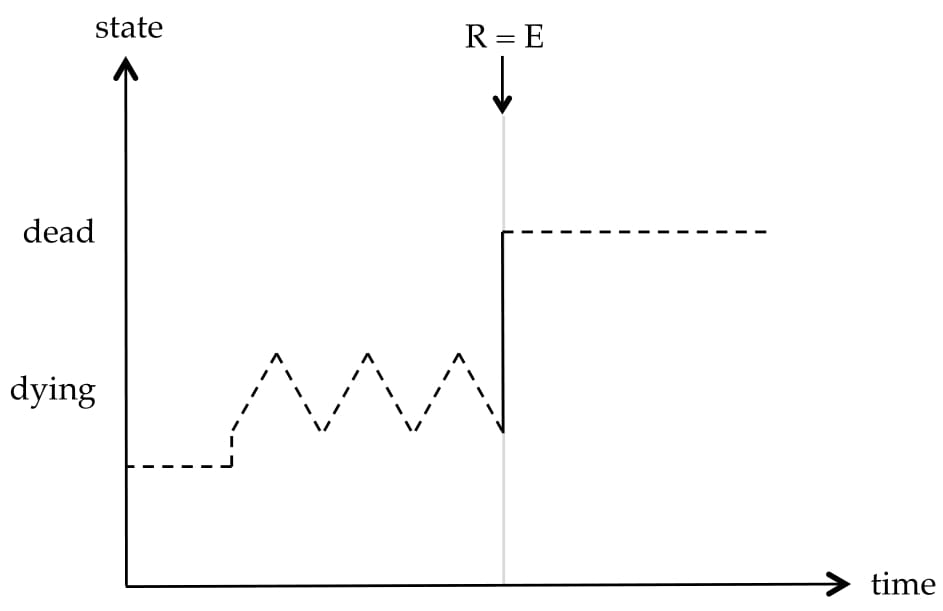
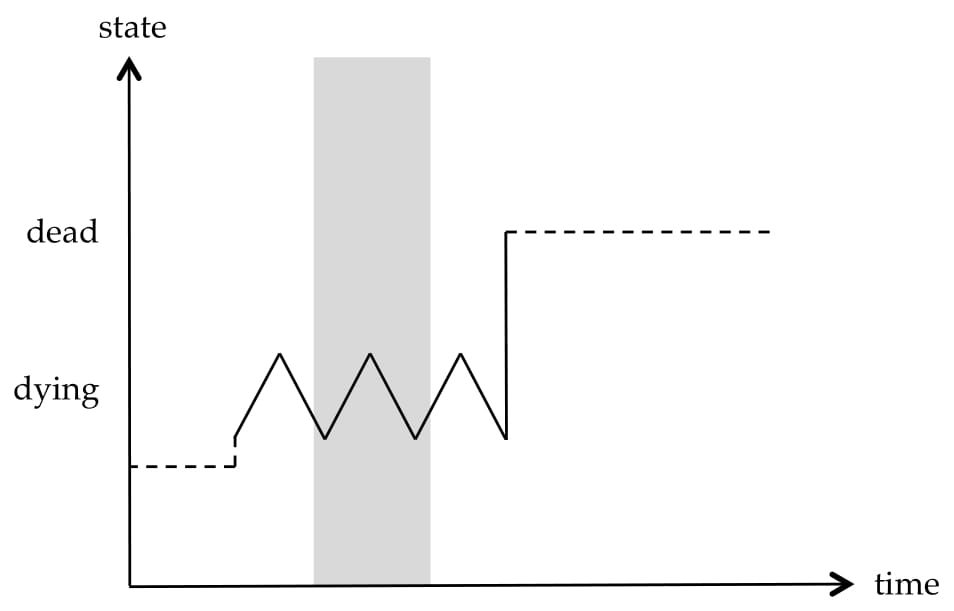
I think it’s really valuable to think about the interaction of the actional potential of verb constellations and grammatical aspect in the way I’ve presented it here. It makes a lot of difference at many places of our interpretation – even when without these considerations we so far hadn’t had any problems with the Greek text. In only occurred now to me, for example (a rather embarrassing admission), that the question of whether θριαμβεύειν is a (causative; cf. Mike Aubrey’s chapter in The Greek Verb Revisited) accomplishment or activity decides whether τῷ πάντοτε θριαμβεύοντι ἡμᾶς in 2. Cor 2:14 should be translated as “… who leads us constantly in his triumphal procession” or as “who leads us in all his triumphal processions”! Thus, the decision concerning the actional potential of the verb constellation determines whether we have to think of a single or a multitude of processions when it comes to the metaphor. It’s a quite significant difference, I would say, and even if it doesn’t cause any big changes to our understanding of early Christian literature as a whole at this point, I don’t think we would just shrug this off in other areas. For example, I can’t imagine that we would be comfortable with mistaking plural nouns for singular nouns are the other way around.
Pure aspectual opposition
You will notice that pure aspectual opposition – where there is a difference in conceptualization of the situation without a transformation of the situation – between imperfective and perfective aspect is actually quite rare. Of course, authors often can choose between different aspects with a variety of situation types. For example, assuming that Noah did indeed built the ark, both imperfect and aorist indicative are acceptable (the imperfect does not make the claim that no end-point exists!). But also note that the situations they communicate still differ.
In fact, when it comes to speaking about the past (as we do in prototypical narratives), it’s only with activities that the two aspects express the same situations. Thus, it’s only in the choice between a “linear” ipf. and a “complexive” aor. (cf. AGG 194b and 194h) that the same truth-conditions apply. Only here do we have other conceptual differences, i.e. “emphases” that don’t affect the contexts in which the usages would be acceptable or not. For example, the imperfect can communicate a shorter distance to the events in question. Von Siebenthal speaks about the imperfect tending “to draw the hearer’s/reader’s attention more to the particulars, often describing them in graphic detail” (AGG 198l). He adduces Acts 21:20 as an example: Οἱ δὲ ἀκούσαντες ἐδόξαζον τὸν θεὸν εἶπόν τε αὐτῷ. His paraphrase reads: “When they heard this, they praised God (for some time and in various ways) until they (finally) said …” In a recent article, Bentein has argued that the internal perspective of the imperfective aspect can imply a kind of “virtual character” who witnesses the events. From a narratological perspective I would interpret this similarly: we have a closer narrative distance (i.e. we are encouraged to imagine more details) and this can be interpreted as a potential signal of focalization, specifically as implying in certain text that the text encourages us to imagine that the narrator him- or herself takes part in the events. Here’s a great dissertation topic for you: Analyse the imperfects in the We-passages in the book of Acts in comparison to the rest of the work … You’re welcome!
Working with grammars
I’ve already explained how knowing about aspect and Aktionsart is important for our interpretation of biblical texts. Furthermore, it seems to me that without this framework exegetes are often at a loss when it comes to how exactly reference grammars may help them in their research. Sometimes, we seem to sit before our grammars, choosing an “aspectual nuance” for our passage, as if we had a menu before us. But we fool ourselves if we think that we are mostly dealing with interpretive options that we can choose as soon as they seem contextually plausible. The choices an author has with regard to aspect and the level on which his or her decision has consequences vary enormously depending on other, mostly lexical, choices. Accordingly, our choices in interpreting texts must also be guided by the same principles.
Take for example “inceptive/ingressive” and “effective/resultative” aorists. In some grammars (note however AGG 194i and 194j, with a small but significant addition to the German version) you get the impression that as an exegete your decision of whether or not any aorist verb form is either of the two is almost exclusively dependent on contextual factors – in other words, you can decide for whichever option fits your interpretation best. However, the two categories are actually significantly different things! In (a) the effective aorist, the whole situation is in view, as it is normal for the perfective aspect, but we have a specific emphasis on the telic end point of the situation. That of course assumes that we are dealing with an accomplishment or achievement. On the other hand, we have a case of (b) an inceptive aorist if the perfective aspect is combined with a stative action potential. A state is stative, there is no change within the state. Accordingly, the perfective aspect, in search for beginning and end points, focuses on the change that actually results in the state.
For example, if the state of “having faith” is portrayed through the perfective aspect, the reference time will include precisely the move towards faith. [Subject πιστεύειν ὅτι-clause] in John 20:31a (ταῦτα δὲ γέγραπται ἵνα πιστεύ[σ]ητε ὅτι Ἰησοῦς ἐστιν ὁ χριστὸς ὁ υἱὸς τοῦ θεοῦ) demonstrates how relevant such a shift in reference time can be. In πιστεύ[σ]ητε the text-critical decision makes a big difference in what is meant. The imperfective aspect is a necessary condition for the thesis that the gospel is meant to strengthen faith; the perfective aspect is in fact a sufficient condition for an evangelistic function!
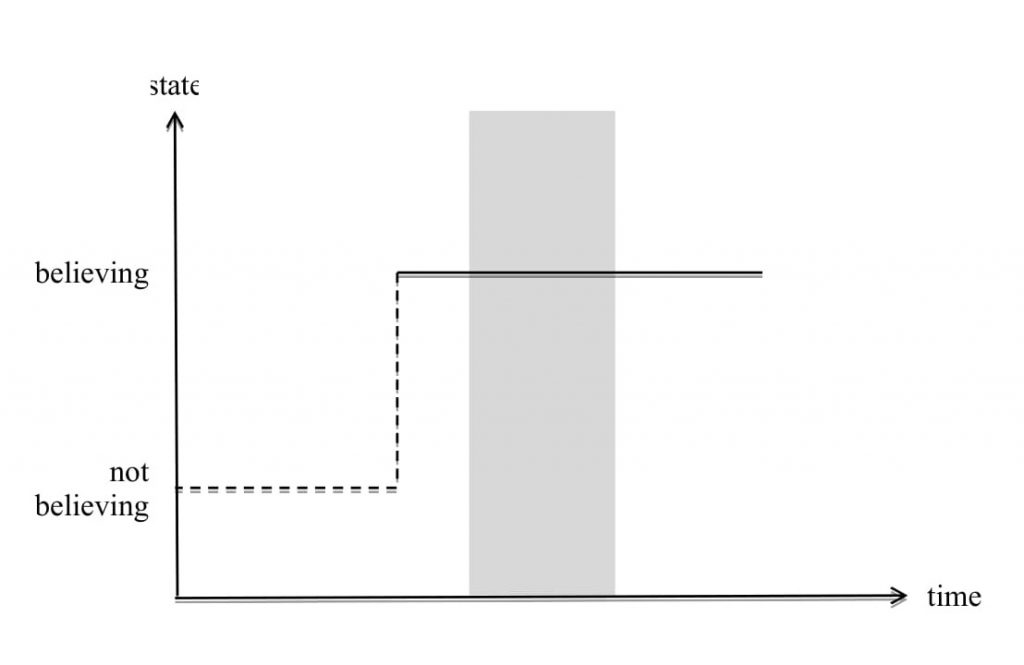
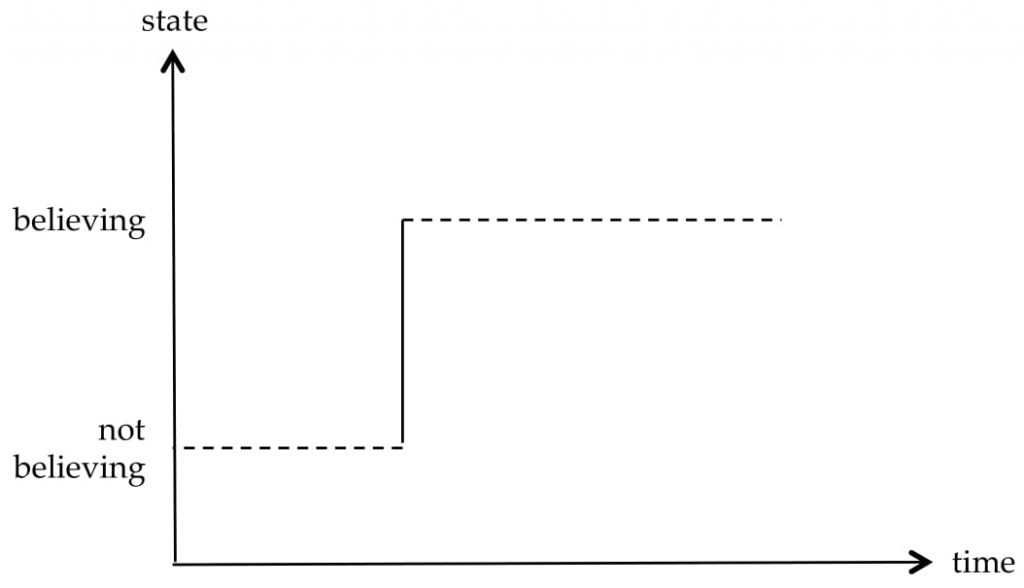
Note that this is not just a shift of reference time with regard to event time. It results in a transformation of the situation type in question. In other words, an inceptive aorist does not portray a state with a focus on its beginning in the way the effective aorist focuses on the inherent end point of a telic situation. Rather, the vertical line in the above figures is now the new situation in question and it is of course telic. Whether or not the state that results from this transformation or not continues is now entirely a contextual matter – just as the successful construction of an ark doesn’t mean that the resulting state in any way continued to the time of speaking.
Thus, to sum up, despite the fact that the two aspectual nuances often appear side by side in reference grammars, does not mean that you as an exegete have to decide in individual cases which of the two the author meant. Unless the verb in question has both state and telic meanings, there’s really no choice at all between the two to be made by you.
Working with lexicons
In closing, let’s return to lexicography. In order to decide how aspect interacts with the actional potential of verb constellations, you first need to know which situation type the verb constellations in your text represent. You’ll find some references to previous work on this question in Thomson’s essay. Unfortunately, Greek lexicons themselves don’t give you the relevant information directly. There are tests for situations types (cf. e.g. here for Van Valin’s tests), but most of them have not taken into account the specifics of Greek. They will mostly help you in getting a clearer picture of the situation type to which the English definitions (or German glosses) belong.
Ideally, the definition will at least specify telicity. The problem with glosses (see part 2 of this series) becomes very obvious here, because they are often misleading or at least ambiguous. To be fair, in the case of κατασκευάζειν we don’t seem to have a problem. The definition in BDAG is ‘to bring a structure into being’ – so that, of course, this task is only accomplished once the structure has come into being. Even the glosses are quite straightforward. Note that in German the verb “bauen” can be an activity (at least with “an”). In English, however, “to build” really seems to be used exclusively as an accomplishment: You can say “I built this in one hour” (which wouldn’t be possible with activities) but you can’t say “I vigorously built this” (which should be possible if the verb had also an activity sense). So if you go with the glosses here you won’t be misled in this particular case.
However, things are not always that easy unfortunately. That’s mainly because lexicons often reflect outdated views of aspect – or even ideas that never had any plausibility. That affects not just verbs. For example, I was surprised to see the entry for ὅτε in BDAG. They say it has the following meanings:
| Definition | glosses | role of aspect |
| ‘marker of point in time that coincides with another point in time’ | “when” | “Predominantly with the aorist.” |
| ‘marker of a period of time coextensive with another period of time’ as long as, while | “as long as,” “while” | No aorist examples are offered. |
They don’t say exactly that this is a distinction is tied to different aspects, but it is certainly a very plausible implication. And that would seem to be very strange against the background of what we’ve discussed so far. If the temporal clause contains a perfective depiction of a situation, we would expect it to express anteriority in comparison to the main clause. If by contrast the temporal clause offers an imperfective perspective, we would expect the main clause to be embedded into this continuing situation (cf. AGG 276 for exactly that tentative association). But instead of differentiating between anteriority and simultaneity, BDAG differentiates between durativity and punctuality of the situations in the temporal clause. I just can’t see any good prima facie reason for doing so. And the examples that are adduced don’t help either! To be sure, in almost all the examples for the first sense a translation with “when” or “als” in German seems possible. But don’t overlook the fact that these words are polysemous in German/English too and can express both simultaneity and anteriority! The Wörterbuch der Deutschen Gegenwartssprache,for example, offers the following two definitions for “als”: ‘verbindet zwei gleichzeitige Vorgänge’ (i.e. ‘combines two simultaneous processes’) and ‘verbindet zwei unmittelbar aufeinanderfolgende Vorgänge’ (i.e. ‘combines two directly sequential processes’). It seems to be the case that both in German and in English past anterior forms are used with these subordinating conjunctions if both situations are located in the past in order to clarify the relationship. Just look at the first example adduced by BDAG (Mat 9:25): ὅτε δὲ ἐξεβλήθη ὁ ὄχλος εἰσελθὼν ἐκράτησεν τῆς χειρὸς αὐτῆς, καὶ ἠγέρθη τὸ κοράσιον. The taking of the hand happened “when” (=after) the crowd had left. I don’t know for sure what happened with this BDAG entry, but I can’t avoid the impression that ideas about the “punctular” aorist influenced here a distinction in the senses that seems entirely incorrect. Note also that this confusion seems to have been facilitated by a mistaken focus on glosses, with the authors focusing on one of the senses behind the German/English gloss and constructing their definition on that basis.
The same caveats unfortunately apply when it comes to verbs. The entries in our lexicons don’t really seem to pay any attention to the kinds of problems you as an exegete will have. Let’s return to the illustration of “Bloggs drowned” vs. “Bloggs was drowning” again. Wayne Coppins pointed me to Mark 5:13 for a nice analogy in Greek: καὶ ἐπνίγοντο ἐν τῇ θαλάσσῃ. Almost universally it’s translated as “and they were drowned in the lake” (the NAS has “were drowning” in a note). Let’s assume for a moment [Subject πνίγω] is indeed telic, just like [Subject drown], with the inherent end point being the killing of the person in question in the prototypical case. If this hypothesis were right, we would not expect it to be used in the aorist stem at places, where this end point isn’t reached. I haven’t looked at all attestations, but I carried out the cross-check. And indeed, in Mt 18:28 we find the imperfective aspect with just such a sense: καὶ κρατήσας αὐτὸν ἔπνιγεν. Owing to the grab the flow of breath was restricted but without fatal result.
So it is at least a very plausible hypothesis that something similar can probably also be said with regard for the pigs – who “were drowning.” Note that it is possible that some of them already had drowned, but they as a group had not done so yet collectively. As Mike Aubrey pointed out to me, we can also see “nominal aspect” at work here:
“Nominal aspect separates out noun types by (1) shape and (2) homogeneity (best illustrated by the distinction between count nouns, non-homogenous, and mass nouns, entirely homogenous). Analogically, the speaker made a choice to use a homogenous singular for ὥρμησεν ἡ ἀγέλη and, after introducing an overt quantity, a less homogenous plural for καὶ ἐπνίγοντο ἐν τῇ θαλάσσῃ.“
Note also that this of course doesn’t mean that some of the pigs survived. Mark probably wants us to imagine that the herdsmen went away while all this was still going on (cf. v. 14). Luke, by contrast, just has the pigs drown in the aorist indicative (8:33: καὶ ἀπεπνίγη) and makes the herdsmen observe the whole scene (v. 34: ἰδόντες δὲ οἱ βόσκοντες τὸ γεγονὸς ἔφυγον). It is beyond the scope of this essay, but perhaps this example also already demonstrates for you that a synoptic comparison cannot just compare lexical and aspectual “choice” but must also close consider how the corresponding situations are perhaps presented differently (and how that might cause other changes in the text).
What you’ve read are at least my first impressions when looking at Mark 5:13. However, if you want to make sure this is correct, you will probably check a dictionary to see whether my assumptions about the actional potential of the verb constellation are correct. I expect that the definitions in BDAG will frustrate you quite a bit when it comes to make this decision:
1. ‘to apply pressure around the neck in order to kill,’ “strangle”
2. ‘to cause someth. to be stifled,’ “choke”
Not being a native speaker, I must confess that I am not entirely sure how to understand “stifled” in that case. To me it also seems to imply death just as the first definition, which clearly contains such a telos (“in order to kill”). But the Cambridge Dictionary says: ‘to prevent, or be prevented, from breathing (easily).’ The “easily” seems to move the goalpost away from ultimate dying. Be that as it may, at least the gloss “choke” seems to be clearly ambiguous. Cambridge Dictionary defines the verb as ‘to (cause to) stop, or partly stop, breathing.’ I guess the entry in BDAG don’t mean “partly” in this context because the gloss “drown” is offered for Mk 5:13 later on and this word seems to go all the way again (‘to (cause to) sink in water and so suffocate and die’). But that of course assumes that when it comes to “drowning” the authors were thinking more than when they adduced “choking”… To me it seems like there are several theoretical possibilities when it comes to πνίγω and it’s frustrating that BDAG doesn’t address them in any systematic manner:
- Does πνίγω have several senses, at least one of them not being telic but perhaps just constituting an activity of restricting the flow of breath? Then I want a definition that is clearly an activity.
- Does the verb perhaps have several telic senses, with different goals? Note that “stopping breathing partly” is also telic, it’s just not such an extreme goal. I noticed this before with φεύγω, which is the prime example for a telic verb. After all, it expresses a movement from (dangerous) A to (safe) B, right? When looking at aor. ind. occurrences in the TLG I was wondering: What does it mean that it’s used for flights that don’t reach safe place “B”? Perhaps it’s still not an activity of being “on the flight” (which would be one possible explanation) but “B’” is simply: “not A”, i.e. the goal is reached as soon as the place is left (even though the individuals might of course have other “goals” in mind). Well, if that were the case, I would certainly appreciate a set of different definitions specifying the different goals.
- Is this a telic verb constellation with a pretty uniform endpoint that implies reaching death of some kind and are the apparent options 1 and 2 perhaps simply the result of coercion/reinterpretation in the imperfective aspect? Note that they offer the gloss “choke” specifically “of weeds in relation to good seed.” They refer to Herm. Sim. 5.2.4. and construct the example ὁ ἀμπελὼν μὴ ἔχων βοτάνας τὰς πνιγούσας αὐτόν based on that text, which they translate progressively as “the vineyard without the weeds that were choking it.” And in fact, the removal of weeds is meant to have the effect that there is more fruit (καὶ βοτάνας μὴ ἔχων δώσει καρπὸν πλείονα), so apparently the weed wouldn’t have choked the vine completely. By contrast, in Mt 13:7, the example from the NT they adduce right next to that, things are different. As in V. 6, the author probably has the complete destruction in mind, whereas it was only on the good soil in V. 8 (ἐδίδου καρπόν) that any fruit appears to have grown. Again, if it’s acpect that determines the kind of situation that is in view, why is aspect not even mentioned in this whole entry?
As you can see, using lexicon articles often requires a lot of effort on the part of the exegete. For the future, let’s hope that new lexicons such as the revision of the Baur-dictionary will do better. In fact, this is the place were you would hear a “call your senator now” in other contexts. And in fact: Yes, it’s up to us as exegetes to make ourselves heard with our needs. So let’s point out the inconsistencies that we face in our daily work and let’s insist on better lexicographical work in the future. We don’t need more dictionaries that don’t pay attention to aspect and Aktionsart.
For the moment, I hope that this blog post offers at least some help. Next time you wonder about what the perfective/imperfective aspects do to the verb you are dealing with, (a) look it up in a dictionary and search for indications concerning stativity, durativity, and telicity. Tests like those by Van Valin might help you. But also remember that the definitions were probably not written with these differentiations consciously in mind and that glosses can be very misleading and you should’t build too much on them. So if you want to be sure, (b) do a BibleWorks or TLG search and watch out for how the verb behaves in its different stems. For example, if you want to know whether there is an effective nuance in a certain verb – let’s take κλείω as a random example – the verb must be telic in the aorist and you’ll find the imperfective aspect being used for cases where the potential goal is not reached (e.g. for κλείω you’ll find ὡς δὲ ἡ πύλη ἐκλείετο ἐν τῷ σκότει in Jos 2:5).
Outlook
My plan is to write three more pieces, all focused on text grammar. In the next instalment, I want to introduce Heinrich von Siebenthal’s specific approach and discuss on a very general level how it relates to the interpretation of biblical texts. Then I would like to discuss the issues of information structure and discourse markers in the more contributions to this blog. However, I’ll get the proofs of my big book on narratives in Paul’s letters today or tomorrow and I am not sure how much time I’ll find over the coming weeks. Perhaps these first 4 parts of the series will be shared in the meantime on social media. I also welcome comments directly here on the blog. In any case, seeing that the series is read will certainly contribute to my motivation to find some time in between. In case it will take some time, perhaps you want to track down some of the material that I’ve linked to in these posts. They are all worth being read.

Christoph Heilig – currently postdoc in Basel – is the author of Hidden Criticism? (Fortress, 2017) and Paul’s Triumph (Peeters, 2017). This research has recently received the Mercator Award in the Humanities and Social Sciences. Additionally, he has co-edited (with J. Thomas Hewitt and Michael F. Bird) God and the Faithfulness of Paul: A Critical Examination of the Pauline Theology of N. T. Wright (Fortress, 2017).In his most recent – and voluminous – project, which has just been completed, he discusses the importance of “stories” and “narrative substructures” for understanding Paul’s letters. It is currently in press with de Gruyter.
This post was first published on the Zürich New Testament Blog on April 1, 2020.


